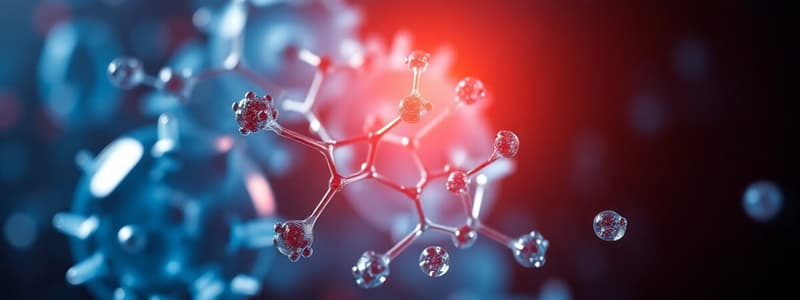Podcast
Questions and Answers
What is the primary role of CYP450 enzymes in drug metabolism?
What is the primary role of CYP450 enzymes in drug metabolism?
What is the main goal of Phase II metabolism in drug elimination?
What is the main goal of Phase II metabolism in drug elimination?
Which of the following is NOT a typical conjugation reaction in Phase II metabolism?
Which of the following is NOT a typical conjugation reaction in Phase II metabolism?
What is the relationship between a drug's half-life and its time to reach steady state?
What is the relationship between a drug's half-life and its time to reach steady state?
Signup and view all the answers
If a drug exhibits zero-order kinetics, what does this mean for its elimination?
If a drug exhibits zero-order kinetics, what does this mean for its elimination?
Signup and view all the answers
What is the major factor influencing the distribution of lipophilic drugs?
What is the major factor influencing the distribution of lipophilic drugs?
Signup and view all the answers
Which of the following is NOT a key factor in drug distribution?
Which of the following is NOT a key factor in drug distribution?
Signup and view all the answers
How does binding of drugs to plasma proteins affect their distribution?
How does binding of drugs to plasma proteins affect their distribution?
Signup and view all the answers
What is the relationship between the volume of distribution (Vd) and the concentration of a drug in the body?
What is the relationship between the volume of distribution (Vd) and the concentration of a drug in the body?
Signup and view all the answers
What is the biological significance of the therapeutic range?
What is the biological significance of the therapeutic range?
Signup and view all the answers
Why is IV administration considered the gold standard for determining bioavailability?
Why is IV administration considered the gold standard for determining bioavailability?
Signup and view all the answers
How does the lipophilicity of a drug influence its ability to cross cell membranes?
How does the lipophilicity of a drug influence its ability to cross cell membranes?
Signup and view all the answers
Which of the following factors contributes to the short duration of hypnosis produced by an IV bolus of propofol?
Which of the following factors contributes to the short duration of hypnosis produced by an IV bolus of propofol?
Signup and view all the answers
Which of the following is NOT a factor influencing drug absorption?
Which of the following is NOT a factor influencing drug absorption?
Signup and view all the answers
What is the significance of bioavailability in pharmacokinetics?
What is the significance of bioavailability in pharmacokinetics?
Signup and view all the answers
What is the primary reason why intravenous administration bypasses absorption?
What is the primary reason why intravenous administration bypasses absorption?
Signup and view all the answers
Why does a drug pass through membranes more readily when it is uncharged?
Why does a drug pass through membranes more readily when it is uncharged?
Signup and view all the answers
How is bioavailability determined for an orally administered drug?
How is bioavailability determined for an orally administered drug?
Signup and view all the answers
Which of the following routes of administration bypasses the first-pass metabolism in the liver?
Which of the following routes of administration bypasses the first-pass metabolism in the liver?
Signup and view all the answers
What is the term for the process of a drug being broken down in the body?
What is the term for the process of a drug being broken down in the body?
Signup and view all the answers
Which of the following factors is NOT a determinant of drug distribution?
Which of the following factors is NOT a determinant of drug distribution?
Signup and view all the answers
Study Notes
Pharmacokinetics Overview
- Pharmacokinetics is the study of drug movement throughout the body.
- It encompasses the processes of absorption, distribution, metabolism, and excretion (ADME).
- Drug administration is the starting point, followed by absorption into the bloodstream.
- Distribution involves drug movement to various tissues and organs throughout the body.
- Drug metabolism is the transformation of the drug in the body, typically in the liver.
- Finally, excretion is the removal of the drug and its metabolites from the body.
Absorption
- Absorption is the process by which a drug enters the bloodstream.
- Key factors affecting absorption include drug properties (ionization, polarity, lipid solubility), route of administration, blood flow to the absorption site, surface area available for absorption, and contact time at the absorption surface.
- Intravenous administration bypasses absorption.
- Different routes of administration have various absorption patterns and associated advantages and disadvantages. Examples include oral, sublingual, intravenous, intramuscular, subcutaneous, inhalation, topical, transdermal, and rectal routes.
Mechanisms of Absorption
- Passive diffusion: Drug molecules move across the membrane from a high concentration to a low concentration, without energy input.
- Facilitated diffusion: A carrier protein helps drug molecules move across the membrane from high to low concentration.
- Active transport: Drug molecules move across the membrane from low to high concentration requiring energy.
- Endocytosis: The cell membrane engulfs the drug, enclosing it within a vesicle.
Drug Ionization and Membranes
- Drug movement across cell membranes is influenced by its charge.
- Uncharged molecules cross membranes more easily.
- Weak acids exist primarily in their uncharged form in acidic environments, and vice-versa.
- Weak bases exist primarily in their uncharged form in alkaline environments, and vice-versa.
Bioavailability
- Bioavailability is the rate and extent to which an administered drug reaches the systemic circulation.
- It is expressed as a percentage.
- It is calculated by comparing the area under the drug's plasma concentration-time curve (AUC) after oral or other non-IV administration to the AUC after IV administration.
- Bioavailability is important for calculating dosages for non-IV routes.
- The "true dose" is the amount of drug available to exert its effect, not just the amount swallowed.
Determination of Bioavailability
- Bioavailability is determined by measuring drug levels in the blood and plotting these across time.
- The area under the measured plasma levels graph is the AUC.
- A comparison of the oral and IV AUC levels is performed to calculate bioavailability.
Distribution
- Distribution is the reversible transfer of a drug from the bloodstream to tissues and organs.
- Key factors affecting distribution include blood flow to the tissues, capillary permeability, binding to plasma proteins and tissues, lipophilicity of the drug, and volume of distribution.
- Blood flow is higher to organs with high capillary density like the liver and brain than other tissues.
- Differences in blood flow between tissues and organs are crucial in determining the rate and extent of drug delivery.
Binding of Drugs to Plasma Proteins and Tissues
- Drugs binding to plasma proteins, primarily albumin, can impede further drug distribution to other tissues.
- These bound drugs are non-diffusible.
- Binding to tissue proteins also affects distribution.
Lipophilicity
- Lipophilic drugs, those that dissolve in fat, can easily cross biological membranes and distribute widely.
- Lipophilicity is a major factor influencing distribution.
- Hydrophilic drugs struggle to enter tissue, and distribute to a smaller range of tissues or organs.
Volume of Distribution
- Represents the apparent space in the body that is occupied by a drug.
- Calculated by dividing the amount of drug in the body by the plasma concentration at time zero.
- Crucial for calculating drug dosage.
Metabolism
- Metabolism is the chemical alteration of drugs to enhance their excretion.
- Primarily occurs in the liver, often involving enzymes like CYP450.
- Phase I metabolism: Oxidation, reduction, or hydrolysis of the drug, can lead to more polar compounds.
- Phase II metabolism: Conjugation reactions with endogenous molecules that result in more polar water-soluable compounds.
Excretion
- Excretion is the removal of drugs and metabolites from the body.
- Main routes are renal (urine), hepatic (bile, feces), and other routes (sweat, breast milk, exhalation).
- Kidney excretion depends on filtration, secretion, and reabsorption processes.
Half-Life and Kinetics
- Half-life is the time required for the drug concentration to reduce by half in the body.
- Drug kinetics includes first-order (constant fraction metabolized per unit time) and zero-order (constant amount metabolized per unit time) processes.
- Dosing adjustments may be needed for patients with liver or kidney dysfunction.
Studying That Suits You
Use AI to generate personalized quizzes and flashcards to suit your learning preferences.
Related Documents
Description
This quiz covers the fundamentals of pharmacokinetics, focusing on the movement of drugs in the body through the processes of absorption, distribution, metabolism, and excretion (ADME). Understand the significant factors impacting drug absorption and the various routes of administration. Test your knowledge of how drugs are processed in the body and their journey from administration to excretion.




